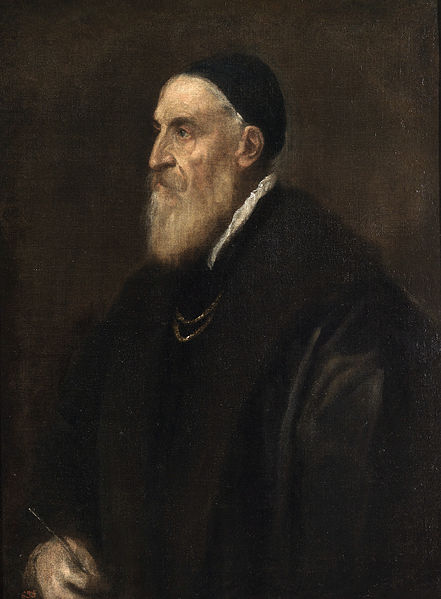
Born: c. 1488-1490, Venice
Died: 27 August 1576 (aged 87-88)
Period: Renaissance
The Life of Titian
Titian, born Tiziano Vecellio around 1488–1490 in Pieve di Cadore, near Belluno in the Venetian Republic, is regarded as one of the greatest painters of the Italian Renaissance. His career spanned over six decades, during which he made significant contributions to painting, mastering and influencing various genres such as portraits, landscapes, and religious subjects. Titian’s work is celebrated for its vibrant use of color, innovative compositions, and profound impact on the development of European painting.
Early Life and Apprenticeship Titian began his artistic training at a young age, moving to Venice to apprentice with Giovanni Bellini, one of the leading Venetian artists of the time. He was also influenced by Giorgione, another prominent Venetian painter, with whom he collaborated on several works. This early period was crucial in shaping Titian’s style, characterized by a harmonious use of color and light to achieve emotional depth and realism.
Rise to Prominence Titian’s talent quickly garnered the attention of the Venetian aristocracy and the Church. One of his early masterpieces, “Assunta” (Assumption of the Virgin, 1516–1518), for the Santa Maria Gloriosa dei Frari in Venice, marked a turning point in his career, showcasing his ability to convey spiritual ecstasy with dramatic naturalism. His success led to commissions from leading figures of the time, including the Holy Roman Emperor Charles V, Pope Paul III, and Philip II of Spain, among others.
Artistic Development and Innovations Throughout his career, Titian continued to evolve his style. He became renowned for his portraits, capturing the psychological complexity of his sitters with unprecedented realism. His religious and mythological scenes are noted for their sensuality and emotional intensity, often using mythology to explore human passions and vulnerabilities. Titian’s late works are characterized by a more free and expressive brushwork, with a use of color that would influence future generations of artists, including Rembrandt and Velázquez.
Late Years and Legacy In his later years, Titian focused on religious themes, producing works of profound emotional depth and technical mastery. Despite the plague that ravaged Venice in 1576, taking the lives of his son and possibly Titian himself in 1576, he remained active until his death, leaving several works unfinished.
Titian’s legacy is vast, with his innovative approaches to painting influencing not just the Venetian school but the entire trajectory of Western art. His mastery of color, light, and shadow, along with his ability to convey the human condition, solidified his status as a key figure of the Renaissance. His works remain central to the study of Renaissance art, celebrated for their beauty, emotional power, and technical innovation.
Titian’s Notable Works
Titian, one of the towering figures of the Renaissance, left a profound legacy through his exploration of color, masterful compositions, and deep psychological insight. Here are ten of his most famous and influential works:
- “Assunta” (Assumption of the Virgin, 1516-1518) – This monumental altarpiece for the Santa Maria Gloriosa dei Frari in Venice is celebrated for its dramatic upward movement and radiant color palette, marking a milestone in Venetian painting.
- “Venus of Urbino” (1538) – Housed in the Uffizi Gallery, Florence, this sensuous portrait is renowned for its eroticism, sophisticated use of color, and complex symbolism, influencing countless artists, including Velázquez and Manet.
- “Bacchus and Ariadne” (1520-1523) – Located in the National Gallery, London, this work depicts the mythological story of Bacchus and Ariadne with dynamic composition and vibrant color, showcasing Titian’s mastery of mythological subjects.
- “The Pesaro Madonna” (1519-1526) – Another masterpiece for the Santa Maria Gloriosa dei Frari, demonstrating Titian’s innovative approach to sacred compositions, integrating patrons into religious narratives.
- “Diana and Actaeon” (1556-1559) – Part of a series of mythological paintings for Philip II of Spain, now jointly owned by the National Gallery, London, and the National Gallery of Scotland, Edinburgh. It’s admired for its dynamic composition and emotional intensity.
- “Equestrian Portrait of Charles V” (1548) – This portrait, commemorating Charles V’s victory at the Battle of Mühlberg, is a masterful depiction of power and authority, located in the Museo del Prado, Madrid.
- “Sacred and Profane Love” (c. 1514) – Housed in the Galleria Borghese, Rome, this enigmatic work features two versions of Venus, exploring themes of love’s dual nature through a rich landscape and detailed symbolism.
- “The Flaying of Marsyas” (c. 1570-1576) – This late work, located in the Kroměříž Archbishop’s Palace, Czech Republic, depicts the gruesome punishment of Marsyas by Apollo. It’s noted for its expressive brushwork and emotional depth.
- “Salome with the Head of John the Baptist” (c. 1515) – An early work demonstrating Titian’s skill in depicting biblical stories with dramatic intensity, located in the Galleria Doria Pamphilj, Rome.
- “Pietà” (c. 1575-1576) – Intended for his own tomb, this work, located in the Gallerie dell’Accademia, Venice, reflects Titian’s contemplation on mortality, showcasing a raw emotional power and a departure from conventional depictions.
Titian’s oeuvre encompasses a wide range of themes, from religious and mythological scenes to portraits and landscapes, all marked by his revolutionary use of color and light. His works have exerted a lasting influence on the trajectory of Western art, cementing his status as one of the greatest painters of the Renaissance.